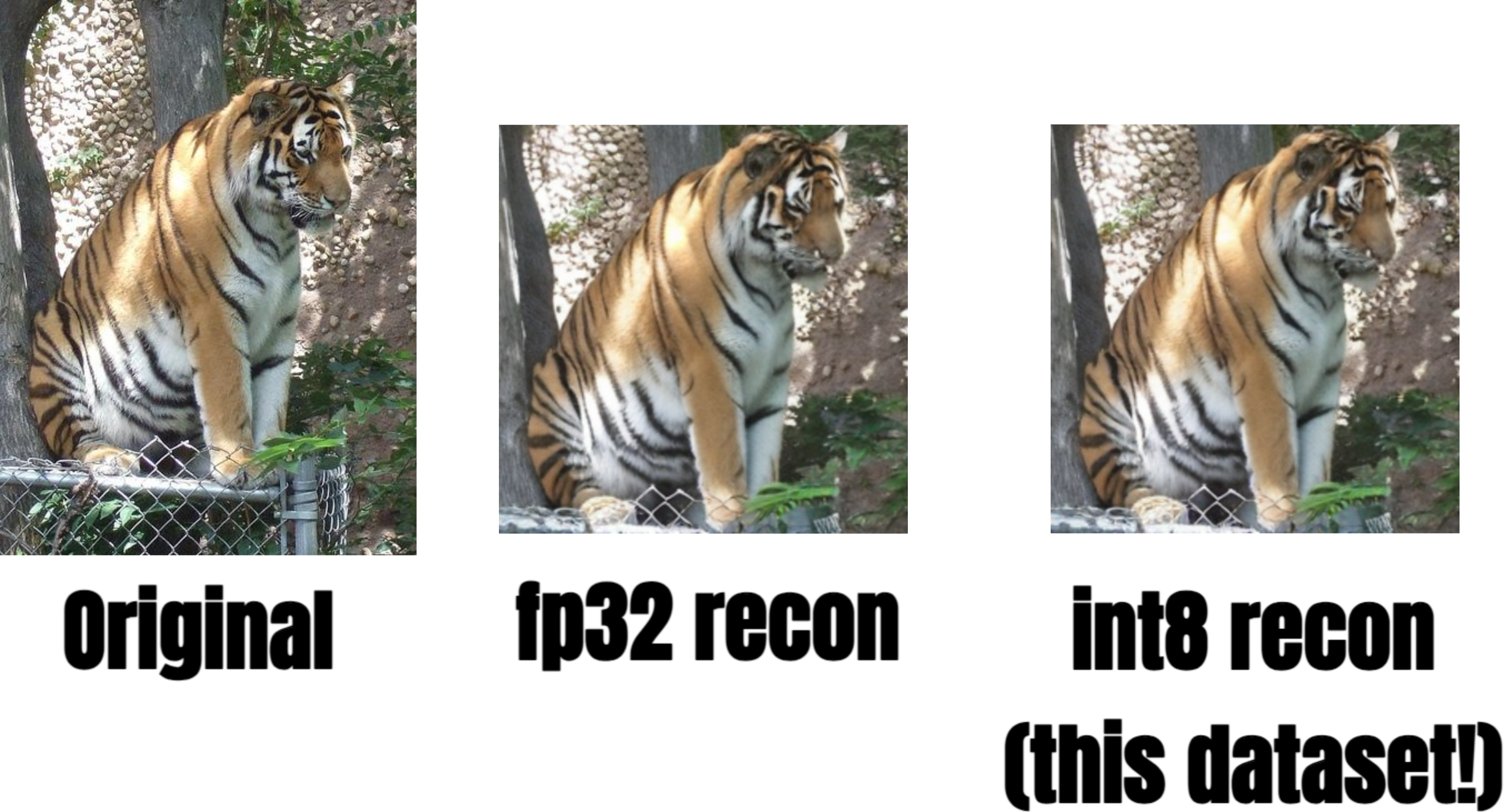size_categories:
- 1M<n<10M
Imagenet.int8: Entire Imagenet dataset in 5GB.

| original, reconstructed from float16, reconstructed from uint8*
Find 138 GB of imagenet dataset too bulky? Did you know entire imagenet actually just fits inside the ram of apple watch?
- Center-croped, resized to 256x256
- VAE compressed with SDXL's VAE
- Further quantized to int8 near-lossless manner, compressing the entire training dataset of 1,281,167 images down to just 5GB!
Introducing Imagenet.int8, the new MNIST of 2024. After the great popularity of the Latent Diffusion era (Thank you stable diffusion!), its almost the standard to use VAE version of the imagenet for diffusion-model training. As you might know, lot of great diffusion research is based on latent variation of the imagenet.
These include:
... but so little material online on the actual preprocessed dataset. I'm here to fix that. One thing I noticed was that latent doesn't have to be full precision! Indeed, they can be as small as int-8, and it won't hurt! Here are some of the examples:
So clearly, it doesn't make sense to download entire Imagenet and do VAE everytime. Just download this, to('cuda') the entire dataset just to flex, and call it a day.😌
(BTW If you think you'll need higher precision, you can always further fine-tune your model on higher precision. But I doubt that.)
How to use?
First download this.
do huggingface-cli download --repo-type dataset cloneofsimo/imagenet.int8 --local-dir ./vae_mds
Then, you need to install streaming dataset to use this. The dataset is MDS format.
pip install mosaicml-streaming
Then, you can use this dataset like this:
from streaming.base.format.mds.encodings import Encoding, _encodings
import numpy as np
from typing import Any
import torch
from streaming import StreamingDataset
from diffusers.models import AutoencoderKL
from diffusers.image_processor import VaeImageProcessor
class uint8(Encoding):
def encode(self, obj: Any) -> bytes:
return obj.tobytes()
def decode(self, data: bytes) -> Any:
x= np.frombuffer(data, np.uint8).astype(np.float32)
return (x / 255.0 - 0.5) * 24.0
_encodings["uint8"] = uint8
remote_train_dir = "./vae_mds" # this is the path you installed this dataset.
local_train_dir = "./local_train_dir"
train_dataset = StreamingDataset(
local=local_train_dir,
remote=remote_train_dir,
split=None,
shuffle=True,
shuffle_algo="naive",
num_canonical_nodes=1,
batch_size = 32
)
train_dataloader = torch.utils.data.DataLoader(
train_dataset,
batch_size=32,
num_workers=3,
)
###### Example Usage. Let's see if we can get the 5th image. BTW shuffle plz
model = "stabilityai/your-stable-diffusion-model"
vae = AutoencoderKL.from_pretrained("stabilityai/sdxl-vae").to("cuda:0")
batch = next(iter(train_dataloader))
i = 5
vae_latent = batch["vae_output"].reshape(-1, 4, 32, 32)[i:i+1].cuda().float()
idx = batch["label"][i]
text_label = batch['label_as_text'][i]
print(f"idx: {idx}, text_label: {text_label}, latent: {vae_latent.shape}")
# idx: 402, text_label: acoustic guitar, latent: torch.Size([1, 4, 32, 32])
# example decoding
x = vae.decode(vae_latent.cuda()).sample
img = VaeImageProcessor().postprocess(image = x.detach(), do_denormalize = [True, True])[0]
img.save("5th_image.png")